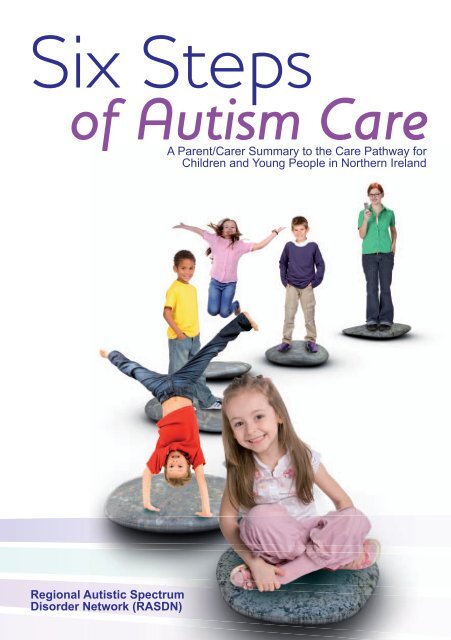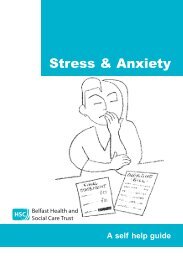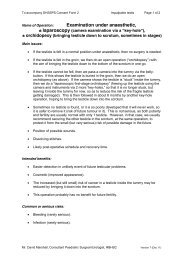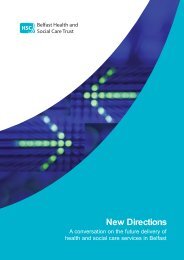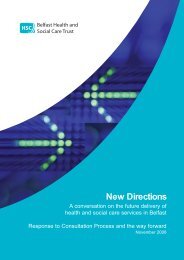Six Steps of Autism Care - Belfast Health and Social Care Trust
Six Steps of Autism Care - Belfast Health and Social Care Trust
Six Steps of Autism Care - Belfast Health and Social Care Trust
You also want an ePaper? Increase the reach of your titles
YUMPU automatically turns print PDFs into web optimized ePapers that Google loves.
<strong>Six</strong> <strong>Steps</strong><strong>of</strong> <strong>Autism</strong> <strong>Care</strong>A Parent/<strong>Care</strong>r Summary to the <strong>Care</strong> Pathway forChildren <strong>and</strong> Young People in Northern Irel<strong>and</strong>Regional Autistic SpectrumDisorder Network (RASDN)
BackgroundThis leafl et has been created to provide parents/carerswith information about the new regional ‘<strong>Six</strong> <strong>Steps</strong> <strong>of</strong><strong>Autism</strong> <strong>Care</strong>’ Pathway for children <strong>and</strong> young people inNorthern Irel<strong>and</strong>.The following information guides you through the stages<strong>of</strong> raising your initial concerns, through to a pr<strong>of</strong>essionaltelling you that your child or young person may haveAutistic Spectrum Disorder (ASD). This journey is nowknown as the ‘<strong>Six</strong> <strong>Steps</strong> <strong>of</strong> <strong>Autism</strong> <strong>Care</strong>’.Why is a care pathway important?This leafl et tells you about the agreed journey your child/young person, <strong>and</strong> you, will take through the integratedassessment, diagnosis <strong>and</strong> intervention process.It will give you information about each step in the processabout who will see your child/young person; which testswill take place; tell you whether your child/young personhas ASD, or not, <strong>and</strong> the follow up support that will bemade available to your child/young person <strong>and</strong> family.
Getting startedAs a parent/carer you may have concerns about your childor young person’s development or whether he/she mayhave autism.Once your GP, health visitor or other pr<strong>of</strong>essional, withwhom you are in contact, is sure that your child/youngperson is experiencing diffi culties, he/she will refer him/herfor an assessment.To start the referral process the pr<strong>of</strong>essional who willmake the referral will complete an <strong>Autism</strong> Service Team(AST) Referral Form which will include informationobtained from you the parent/carer.
The fl ow diagram below outlines the journey along the‘<strong>Six</strong> <strong>Steps</strong> <strong>of</strong> <strong>Autism</strong> <strong>Care</strong>’ pathway.Making a Referralto <strong>Autism</strong> ServicesSt<strong>and</strong>ardisedReferral FormSingle Point <strong>of</strong>Access for allReferralsPreparing for AssessmentFamily InformationLeaflet/Session ProvidedWithin Four Weeks <strong>of</strong> ReferralReferral ScreenedWithin Five DaysReferral DoesNot Meet ServiceCriteriaFurther Assessment(s)required in accordancewith the Child/Young Person’ sDevelopmental StageStep One: First AppointmentDirected ConversationRelationship Building WithinMaximum Waiting Time <strong>of</strong> 13 WeeksChild/Young Person<strong>and</strong> Family Redirectedto Appropriate ServiceStep Two:Integrated Multi-disciplinaryTeam AssessmentNot Autistic SpectrumDisorder (ASD)Step Three: Integrated Multi-disciplinaryTeam FormulationStep Four: Family Feedback <strong>and</strong> <strong>Care</strong> PlanningEarly Intervention ProgrammeStep Five:Integrated Family Intervention <strong>and</strong>Support Services Delivered OverPre-Planned SessionsEducational Based InterventionEnvironmental AdaptionsFamily Support ProgrammeLanguage <strong>and</strong> Communication StrategiesMental <strong>Health</strong> <strong>and</strong> Well-beingPerson-Centred PlanningStep <strong>Six</strong>:Child <strong>and</strong> Family <strong>Care</strong> Plan Reviewat Regular IntervalsPharmacological <strong>Care</strong> (where appropriate)Psychological/Bahavioural Support ProgrammeSensory Processing StrategiesTransitions
The Pathway – step by stepStep One: Once a referral is made by an appropriatepr<strong>of</strong>essional to the specialist AST in your local <strong>Health</strong><strong>and</strong> <strong>Social</strong> <strong>Care</strong> <strong>Trust</strong>, you will be contacted by amember <strong>of</strong> the AST within four weeks with details aboutyour appointment, if the referral has been acceptedfor assessment. At this time the AST will also seekinformation from any services your child/young person iscurrently receiving.If the referral has not been accepted the referral formwill be returned to the referring pr<strong>of</strong>essional with anexplanation/advice about next steps.Step Two: One or more meetings will take place tocarry out some tests with your child/young person. Thisis called the assessment process <strong>and</strong> this can happenat home, at school, or at the <strong>Autism</strong> Clinic. This willcommence within 13 weeks from the referral made to theAST.<strong>Steps</strong> Three <strong>and</strong> Four: Once the ASD assessment hastaken place, you will either be informed on that occasionor at a later meeting, on an agreed date, <strong>of</strong> the outcomes<strong>of</strong> the assessment (tests) <strong>and</strong> be advised if your child/young person has ASD or not, <strong>and</strong> what will happen next.Step Five: Staff will talk to you about the treatments/interventions to be put in place for your child/youngperson. These treatments/interventions are known asthe tailored Intervention <strong>Care</strong> Plan <strong>and</strong> will be based on
your child/young person’s assessed needs. They willcommence within 13 weeks <strong>of</strong> getting your child/youngperson’s diagnosis. Ongoing family support will also bemade available.Step <strong>Six</strong>: When the initial agreed treatment/interventionshave been completed, you will be contacted by the AST,to come for a review appointment to check on your child/young person’s progress. You will be advised <strong>of</strong> a namedworker to support you <strong>and</strong> you may seek advice at anytime. Long-term planning <strong>and</strong> review will be put in place,especially for transition points.Who does the assessment? (Step Two)The team involved in making the ASD diagnosis will comefrom a range <strong>of</strong> pr<strong>of</strong>essional backgrounds, comprising atleast two members from the following list:• paediatrician;• child psychiatrist;• speech <strong>and</strong> language therapist;• occupational therapist;• clinical psychologist;• specialist health visitor;• mental health practitioner;• social worker;• specialist nurse;• educational psychologist;• specialist teacher/advisor;• other trained pr<strong>of</strong>essionals with relevant knowledge <strong>and</strong>expertise.
All pr<strong>of</strong>essionals who carry out assessments for an ASDdiagnosis will have expertise acquired through ASDspecifi c training <strong>and</strong> related conditions, pr<strong>of</strong>essionaldevelopment, supervision <strong>and</strong> work experience.What happens after diagnosis? (<strong>Steps</strong> Four <strong>and</strong>Five)After diagnosis, you will be given a written copy <strong>of</strong>the assessment <strong>and</strong> diagnosis outcome. This will beexplained in such a way that you know what is being said<strong>and</strong> have a clear underst<strong>and</strong>ing <strong>of</strong> the agreed tailoredIntervention <strong>Care</strong> Plan. This is developed in partnershipwith you, for your child/young person<strong>and</strong> your family. You will know thefollowing:-• who will be working withyour child/young person <strong>and</strong> you;• which treatments/interventionsthey will be <strong>of</strong>fering <strong>and</strong> why;• what support will be available toyou, information about agencieswhich can <strong>of</strong>fer help, <strong>and</strong>the contact details <strong>of</strong> yournamed link person who will respondto any queries during or afterthis initial treatment/interventionprocess has been completed.
How can the ‘<strong>Six</strong> <strong>Steps</strong> <strong>of</strong> <strong>Autism</strong> <strong>Care</strong>’ helpyou <strong>and</strong> your family?The new regional ASD <strong>Care</strong> Pathway should mean thatall families using local <strong>Autism</strong> Services experience coordinated<strong>and</strong> responsive support. It will ensure youget the right information, at the right time, from the rightpeople. It will help you to underst<strong>and</strong> the roles <strong>of</strong> theindividuals who will carry out the assessments, so youknow how <strong>and</strong> why the fi nal decision has been made.Useful information / contactsContact the AST/ASD Co-ordinator at your local<strong>Health</strong> <strong>and</strong> <strong>Social</strong> <strong>Care</strong> <strong>Trust</strong> for a list <strong>of</strong> local ASDservices, information on voluntary organisations <strong>and</strong>other useful resources.To view the full version <strong>of</strong> the ‘<strong>Six</strong> <strong>Steps</strong> <strong>of</strong> <strong>Autism</strong><strong>Care</strong>’ document log on to the <strong>Health</strong> <strong>and</strong> <strong>Social</strong> <strong>Care</strong>Board’s website: www.hscboard.hscni.net.Alternative formatsThis leafl et can also be made available in alternativeformats: large print, computer disk, Braille, audio tape ortranslation for anyone not fl uent in English. Please contactthe Communications Offi ce at the <strong>Health</strong> <strong>and</strong> <strong>Social</strong> <strong>Care</strong>Board www.hscboard.hscni.net.


